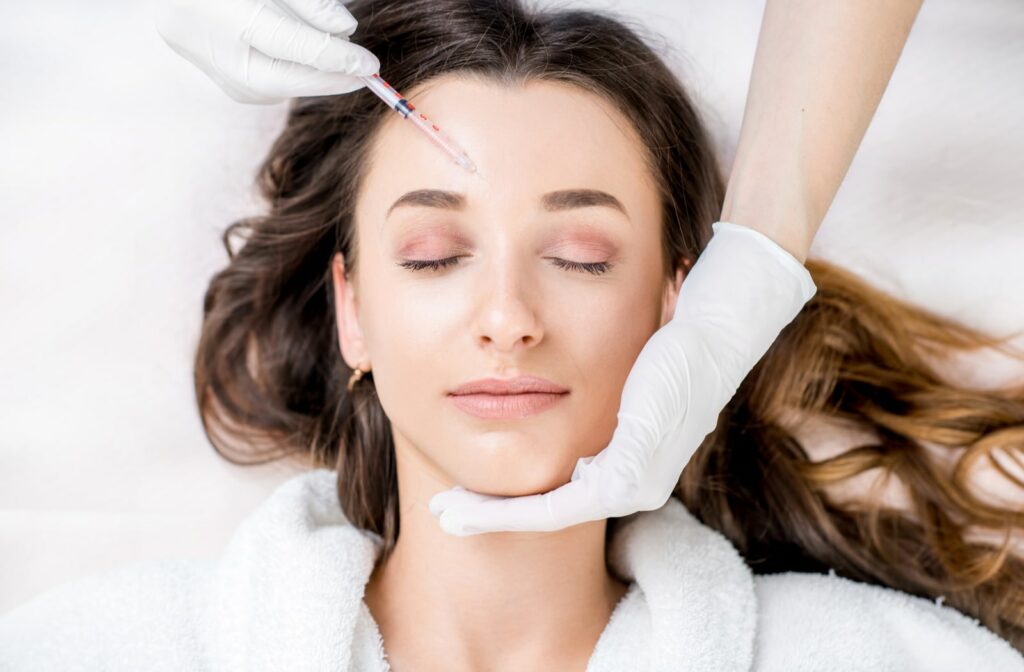How Long Does Botox Take to Work?
Maybe you have some apprehension around getting a botox treatment, and you’re wondering how long it takes to work and how long it’ll last. Typically you’ll start to see results in a few days and they can last for several months. But there are a couple of factors that could affect the timing.
Like any cosmetic procedure, you’ll want to understand exactly what Botox is and ensure you receive treatment from someone qualified with proven results.
What Is Botox?
Botox Cosmetic is a brand name for a Botulinum toxin created by Clostridium botulinum bacteria. It may sound strange calling it a toxin. However, the FDA first approved Botox for therapeutic medical use in 1989 and then extended that approval for cosmetic use in 2002. Botox treatments are safe with minimal side effects.
The procedure is typically performed without any anesthesia. In some cases, the doctor may use a topical anesthetic if you’re worried about possible discomfort. However, the doctor injects the Botox with a very thin needle resulting in minimal discomfort.
How Does Botox Work and How Long Does it Take?
A doctor injects the Botox just beneath the skin into the targeted muscles. It then begins working to block nerve signals to those muscles and stop them from contracting. Depending on how many units are being injected, the procedure doesn’t take more than 10 minutes.
When Will Botox Start Working?
Once the injections are complete, you won’t see results immediately. It takes time for the skin to smooth out after the Botox paralyzes the muscle. Typically, you can expect to notice the treatment working within three to four days. And within two weeks, you should see the full results.
Factors That Affect the Timing
The timeline for results varies slightly person-to-person. Here are a couple of things that can affect how long you’ll wait for results:
- Treatment Area: Depending on what area is being treated with Botox affects the timing because of muscle thickness and density.
Botox Dosage: The amount of Botox the doctor injects plays into how quickly it takes effect. In addition to how quickly it works, the dosage also affects how long the Botox treatment lasts.
How Does Botox Feel When it Starts Working
Most people don’t notice anything more than minor discomfort upon the injection of Botox. As the effects of the Botox begin to work, you’ll notice the treated area feeling tighter. This is the result of the skin smoothing out to get rid of wrinkles.
Is Botox Safe?
Researchers consider Botox safe for therapeutic and cosmetic use when administered in the correct dose. In fact, from 1989 to 2003, there were only 36 adverse side effects reported by the FDA. And almost half of them were likely caused by underlying issues instead of the Botox treatment itself.
It’s also worth noting that these adverse side effects were primarily in therapeutic use. The above study also suggests that cosmetic use of Botox carries much less risk. A major contributing factor to this is the smaller amount of the drug being injected.
Potential Side Effects
Last year, the National Library of Medicine published a research review on Botox and its potential side effects.
- Reddening or swelling of the skin
- Discomfort in the treated area
- Drooping of the eyelid or eyebrow
- Skin discoloration.
Keep in mind that the study also notes that the overall majority of these side effects were temporary and mild.
Alternative to Botox
If you’re looking for an alternative to Botox, AMARA offers several dermal filler options that help you achieve a similar result to Botox.
- Juvederm: There are several types of Juvederm for specific applications. Each one is a synthetic hyaluronic acid that assists in smoothing out lines and wrinkles.
- Radiesse: Lasting up to two years, Radiesse stimulates the collagen beneath your skin for the natural treatment of lines around the nose and mouth.
- Sculptra: Sculptra is another collagen stimulating treatment. It’s a special formulation of poly-L-lactic acid that helps restore the skin’s natural plumpness.
- Belotero: This dermal filler has a hyaluronic acid base. Several consistencies are available depending on the severity of the wrinkle or fold being treated.
- Xeomin: Because it’s also a Botulinum toxin, Xeomin is a dermal filler with similar results to Botox.
- Voluma: This dermal filler is in the same family as Juvederm and primarily helps restore volume to the cheeks.
- Collagen: Naturally-occurring collagen is endogenous collagen, whereas synthetic dermal filler is exogenous collagen. The synthetic form serves the same purpose and function as the body’s natural collagen.
Finding a Qualified Professional
If you have any questions or are ready to book a consultation for Botox or an alternative dermal filler, give us a call today. Let the caring and knowledgeable staff at AMARA answer your questions.



